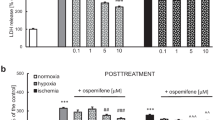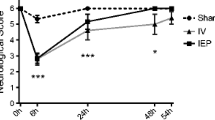Abstract
Objective
To test a possible neuroprotective activity of 17β-estradiol in the neonatal rat brain exposed to hypoxic-ischemia (controlled hypoxia after unilateral carotid artery ligation).
Methods
Seven-day-old Wistar rats underwent ligation of the left common carotid artery followed by 80 minutes hypoxia in 8% oxygen inducing an ipsilateral brain damage. Seven days later (d14), brains were analyzed quantitatively using a macroscopic and microscopic score for structural damage, hemisphere volumes were calculated, and immunohistochemistry for cleaved-caspase-3 (marker for apoptotic cells) was performed. Animals from the study group (n = 19) received 17β-estradiol (0.05 µg/g body weight intraperitoneally) before (−64, −40, and −16 hours) and after (+3 hours) the hypoxia (hour 0: start of the hypoxia) and the control group (n = 21) received mock treatment.
Results
Of the 21 pups, 13 in the NaCl group had macroscopically a severe brain damage and 7 of 19 animals in the study group encountered only discrete to mild lesions. Microscopic brain damage in the study group was significantly lower (score 1.5 ± 0.7 vs 2.8 ± 0.8, P < .05). The determined volumes of the affected hemisphere were significantly lower in the NaCl group than in the treatment group. The numbers of apoptotic cells in both hemispheres was equal in the estradiol group, but in the control group, there were significantly more apoptotic cells in the affected hemisphere (control group: ipsilateral: 1435 ± 653 vs contralateral: 143 ± 57 cells, P < .05).
Discussion
17β-Estradiol protects newborn rat brains from hypoxic-ischemic injury, in terms of both microscopic cell injury and apoptosis.
Similar content being viewed by others
References
Volpe JJ. Brain injury in premature infants: a complex amalgam of destructive and developmental disturbances. Lancet Neurol. 2009;8(1):110–124.
Heron M, Sutton PD, Xu J, Ventura SJ, Strobino DM, Guyer B. Annual summary of vital statistics: 2007. Pediatrics. 2010; 125(1):4–15.
Brazel CY, Rosti RT 3rd, Boyce S, Rothstein RP, Levison SW. Perinatal hypoxia/ischemia damages and depletes progenitors from the mouse subventricular zone. Dev Neurosci. 2004;26(2–4):266–274.
Basu A, Krady JK, O’Malley M, Styren SD, DeKosky ST, Levison SW. The type 1 interleukin-1 receptor is essential for the efficient activation of microglia and the induction of multiple proinflammatory mediators in response to brain injury. J Neurosci. 2002;22(14):6071–6082.
Tulchinsky D, Hobel CJ, Yeager E, Marshall JR. Plama estradiol, estriol, and progesterone in human pregnancy. II. Clinical applications in Rh-isoimmunization disease. Am J Obstet Gynecol. 1972;113(6):766–770.
Wood CE. Estrogen/hypothalamus-pituitary-adrenal axis interactions in the fetus: the interplay between placenta and fetal brain. J Soc Gynecol Investig. 2005;12(2):67–76.
Thomas L. Labor und Diagnose . . . Frankfurt, Germany: TH-Books Verlagsgesellschaft, 1998.
Amateau SK, Alt JJ, Stamps CL, McCarthy MM. Brain estradiol content in newborn rats: sex differences, regional heterogeneity, and possible de novo synthesis by the female telencephalon. Endocrinology. 2004;145(6):2906–2917.
Manthey D, Behl C. From structural biochemistry to expression profiling: neuroprotective activities of estrogen. Neuroscience. 2006;138(3):845–850.
Behl C. Oestrogen as a neuroprotective hormone. Nat Rev Neurosci. 2002;3(6):433–442.
Henderson VW. Action of estrogens in the aging brain: dementia and cognitive aging. Biochim Biophys Acta. 2010;1800(10): 1077–1083.
Brown CM, Suzuki S, Jelks KA, Wise PM. Estradiol is a potent protective, restorative, and trophic factor after brain injury. Semin Reprod Med. 2009;27(3):240–249.
Bryant DN, Sheldahl LC, Marriott LK, Shapiro RA, Dorsa DM. Multiple pathways transmit neuroprotective effects of gonadal steroids. Endocrine. 2006;29(2):199–207.
Wise PM, Dubal DB, Wilson ME, Rau SW, Bottner M, Rosewell KL. Estradiol is a protective factor in the adult and aging brain: understanding of mechanisms derived from in vivo and in vitro studies. Brain Res Brain Res Rev. 2001;37(1–3):313–319.
Berger R, Garnier Y. Pathophysiology of perinatal brain damage. Brain Res Brain Res Rev. 1999;30(2):107–134.
Shankaran S, Laptook AR, Ehrenkranz RA, et al. Whole-body hypothermia for neonates with hypoxic-ischemic encephalopathy. N Engl J Med. 2005;353(15):1574–1584.
Edwards AD, Brocklehurst P, Gunn AJ, et al. Neurological outcomes at 18 months of age after moderate hypothermia for perinatal hypoxic ischaemic encephalopathy: synthesis and meta-analysis of trial data. BMJ. 2010;340:c363.
Tagin MA, Woolcott CG, Vincer MJ, Whyte RK, Stinson DA. Hypothermia for Neonatal Ischemic Encephalopathy: An Updated Systemic Review and Meta-analysis [published online February 6, 2012]. Arch Pediatr Adolesc Med.
Chan WY, Lorke DE, Tiu SC, Yew DT. Proliferation and apoptosis in the developing human neocortex. Anat Rec. 2002;267(4): 261–276.
Yager JY, Ashwal S. Animal models of perinatal hypoxic-ischemic brain damage. Pediatr Neurol. 2009;40(3):156–167.
Rice JE, 3rd Vannucci RC, Brierley JB. The influence of immaturity on hypoxic-ischemic brain damage in the rat. Ann Neurol. 1981;9(2):131–141.
Vannucci RC, Vannucci SJ. Perinatal hypoxic-ischemic brain damage: evolution of an animal model. Dev Neurosci. 2005; 27(2–4):81–86.
Nunez J, Yang Z, Jiang Y, Grandys T, Mark I, Levison SW. 17beta-estradiol protects the neonatal brain from hypoxia-ischemia. Exp Neurol. 2007;208(2):269–276.
Gerstner B, Lee J, DeSilva TM, Jensen FE, Volpe JJ, Rosenberg PA. 17beta-estradiol protects against hypoxic/ischemic white matter damage in the neonatal rat brain. J Neurosci Res. 2009; 87(9):2078–2086.
Brown AW, Brierley JB. Anoxic-ischaemic cell change in rat brain light microscopic and fine-structural observations. J Neurol Sci. 1972;16(1):59–84.
Paxinos G, Watson C. The rat brain in stereotaxic coordinates. Sydney, Australia: Academic Press, 1986.
Jensen FE. Developmental factors regulating susceptibility to perinatal brain injury and seizures. Curr Opin Pediatr. 2006; 18(6):628–633.
Grady D, Rubin SM, Petitti DB, et al. Hormone therapy to prevent disease and prolong life in postmenopausal women. Ann Intern Med. 1992;117(12):1016–1037.
Chen S, Nilsen J, Brinton RD. Dose and temporal pattern of estrogen exposure determines neuroprotective outcome in hippocampal neurons: therapeutic implications. Endocrinology. 2006; 147(11):5303–5313.
Perlman JM. Intervention strategies for neonatal hypoxic-ischemic cerebral injury. Clin Ther. 2006;28(9):1353–1365.
Coumans AB, Middelanis JS, Garnier Y, et al. Intracisternal application of endotoxin enhances the susceptibility to subsequent hypoxic-ischemic brain damage in neonatal rats. Pediatr Res. 2003;53(5):770–775.
Dobbing J, Sands J. Comparative aspects of the brain growth spurt. Early Hum Dev. 1979;3(1):79–83.
Lauterbach MD, Raz S, Sander CJ. Neonatal hypoxic risk in preterm birth infants: the influence of sex and severity of respiratory distress on cognitive recovery. Neuropsychology. 2001;15(3): 411–420.
Antonsson B. Bax and other pro-apoptotic Bcl-2 family ‘‘killerproteins’’ and their victim the mitochondrion. Cell Tissue Res. 2001;306(3):347–361.
Alkayed NJ, Goto S, Sugo N, et al. Estrogen and Bcl-2: gene induction and effect of transgene in experimental stroke. J Neurosci. 2001;21(19):7543–7550.
Zhang Y, Tounekti O, Akerman B, Goodyer CG, LeBlanc A. 17-beta-estradiol induces an inhibitor of active caspases. J Neurosci. 2001;21(20):RC176.
Gown AM, Willingham MC. Improved detection of apoptotic cells in archival paraffin sections: immunohistochemistry using antibodies to cleaved caspase 3. J Histochem Cytochem. 2002; 50(4):449–454.
Nakajima W, Ishida A, Lange MS. Et al. Apoptosis has a prolonged role in the neurodegeneration after hypoxic ischemia in the newborn rat. J Neurosci. 2000;20(21):7994–8004.
Aussel C, Laliberte F, Masseyeff R. Alpha-fetoprotein favours accumulation of estrone but not arachidonic acid into the fetal and new-born rat brain. Life Sci. 1985;36(5):479–484.
Nunez EA, Benassayag C, Vallette G, et al. The role of nonesterified fatty acids and of alpha 1-fetoprotein in estrogen-dependent endocrine systems. Ann N Y Acad Sci. 1983;417:137–148.
Doyle LW, Crowther CA, Middleton P, Marret S, Rouse D. Magnesium sulphate for women at risk of preterm birth for neuroprotection of the fetus. Cochrane Database Syst Rev. 2009;(1): CD004661.
Portmann-Lanz CB, Schoeberlein A, Huber A, et al. Placental mesenchymal stem cells as potential autologous graft for pre- and perinatal neuroregeneration. Am J Obstet Gynecol. 2006;194(3): 664–673.
Portmann-Lanz CB, Schoeberlein A, Portmann R, et al. Turning placenta into brain: placental mesenchymal stem cells differentiate into neurons and oligodendrocytes. Am J Obstet Gynecol. 2010;202(3):294. e1-294. e11.
Schoeberlein A, Mueller M, Reinhart U, Sager R, Messerli M, Surbek DV. Homing of placenta-derived mesenchymal stem cells after perinatal intracerebral transplantation in a rat model. Am J Obstet Gynecol. 2011;205(3):277. e1-6.
Trotter A, Maier L, Pohlandt F. Management of the extremely preterm infant: is the replacement of estradiol and progesterone beneficial? Paediatr Drugs. 2001;3(9):629–637.
Hunt R, Davis PG, Inder T. Replacement of estrogens and progestins to prevent morbidity and mortality in preterm infants. Cochrane Database Syst Rev. 2004;(4):CD003848.
Author information
Authors and Affiliations
Corresponding author
Rights and permissions
About this article
Cite this article
Müller, M.M., Middelanis, J., Meier, C. et al. 17β-Estradiol Protects 7-Day Old Rats From Acute Brain Injury and Reduces the Number of Apoptotic Cells. Reprod. Sci. 20, 253–261 (2013). https://doi.org/10.1177/1933719112452471
Published:
Issue Date:
DOI: https://doi.org/10.1177/1933719112452471




